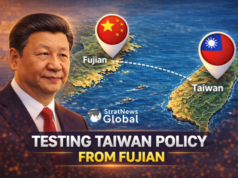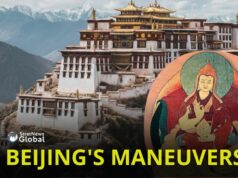In an ever-changing world, the most significant geopolitical and technological shifts often go unnoticed—until they become impossible to ignore.
A fascinating paper by the Atlantic Council highlights six such emerging trends, calling them “snow leopards”: rare, elusive phenomena that could have an outsized impact on global affairs in this year and beyond. This is part of Global Foresight series being run by the Atlantic Council’s SnowCroft Center For Strategy and Security
These developments—ranging from undersea cyber threats to a looming race for Antarctica—demand greater scrutiny as they have the potential to redefine power structures, security dynamics, and technological frontiers.
1. Undersea Peril
The world’s digital infrastructure relies almost entirely on a vast network of undersea fibre-optic cables, transmitting 99% of global data, including sensitive military and financial transactions. However, these cables remain highly vulnerable to physical attacks, with non-state actors and hostile nations increasingly recognizing their strategic significance.
In 2013, an attack off the coast of Egypt disrupted internet services across three continents. Recent reports highlight multiple incidents of damage to undersea cables in the Baltic Sea, with suspicion falling on Russian-linked vessels, including potential sabotage to the Nord Stream pipelines. And suspected Chinese vessels have been linked to damage on undersea cables connecting Taiwan to its outlying islands, potentially impacting internet connectivity.
More recently, Yemen’s Houthi rebels have issued threats against these vital connections. As geopolitical tensions escalate, the risk of sabotage grows, prompting urgent discussions on securing these crucial arteries of the global economy and communication.
One such critical infrastructure project at risk is the India-Middle East-Europe Economic Corridor (IMEC), which heavily depends on undersea data cables to facilitate trade and digital connectivity. Any disruption to these cables could have profound economic and security implications for the regions involved, potentially slowing the project’s progress and threatening its long-term viability. This is one snow leopard definitely worth watching.
2. Hot Tip
Long considered a niche energy source, geothermal power is on the brink of a massive expansion. New technological advancements now make it possible to harness geothermal energy far beyond traditional hotspots like Iceland or the Pacific Ring of Fire. This could enable the U.S. (and other nations) to power nearly half of its homes with a reliable, emissions-free source of electricity.
Unlike wind and solar energy, geothermal provides constant power without reliance on weather conditions. With rising energy demands and growing climate concerns, this development could transform the global renewable energy landscape, challenging the dominance of fossil fuels.
3. Capturing Carbon
Carbon capture technology has long been hailed as a potential weapon against climate change, yet high costs and energy demands have slowed its adoption. Enter COF-999, a breakthrough material capable of capturing carbon from the atmosphere more efficiently than any previous method.
If scaled successfully, this innovation could significantly bolster global climate efforts, potentially reversing some of the damage caused by decades of greenhouse gas emissions. The challenge now lies in funding and implementing this technology at a pace fast enough to make a real difference.
4. Power Redefined
In the realm of healthcare, quantum battery technology is poised to revolutionize medical implants such as pacemakers and neurostimulators. Unlike conventional lithium-ion batteries, quantum batteries charge almost instantaneously and have significantly longer lifespans.
For millions of patients worldwide, this could mean fewer invasive surgeries to replace depleted batteries, reducing both medical costs and health risks. As research progresses, quantum battery applications may extend beyond medicine, offering advancements in fields from consumer electronics to space exploration. It’s a snow leopard that could be defined as a quantum leap in stored power.
5. The Gen Z Dilemma
Despite being the most digitally connected generation in history, Gen Z faces a growing challenge in distinguishing credible information from misinformation. The sheer volume of online content, coupled with increasingly sophisticated disinformation campaigns, is leading to a crisis of trust in institutions, media, and even scientific consensus.
The implications of this shift are profound. As Gen Z matures into leadership roles, their ability—or inability—to navigate this informational minefield will shape political movements, public policy, and societal cohesion in the years ahead.
6. Frozen Stakes
Antarctica, long protected under the 1959 Antarctic Treaty, may soon become the stage for a major geopolitical contest. The treaty, which bans military activity and resource extraction, is set for review in 2048, but nations are already positioning themselves for potential claims.
China, in particular, has ramped up its presence with multiple research stations, hinting at long-term strategic ambitions. The continent’s untapped reserves of oil, gas, and rare minerals could spark a new Cold War-like competition, forcing a reassessment of international agreements governing the region. And no, you won’t find real snow leopards in Antarctica, because they apparently prefer mountainous regions across countries like China, India, Nepal, Mongolia, Pakistan, and Russia.
These six “snow leopards”—each a potential disruptor in its own right—highlight the need for foresight and adaptability in global strategy. Whether it’s securing undersea communications, revolutionizing energy systems, or preparing for a new era of territorial competition, the world must be ready for the unexpected.
As 2025 unfolds, each of these snow leopards or these hidden forces may no longer remain in the shadows, but instead shape the next chapter of history.
Read the full report here
In a career spanning three decades and counting, Ramananda (Ram to his friends) has been the foreign editor of The Telegraph, Outlook Magazine and the New Indian Express. He helped set up rediff.com’s editorial operations in San Jose and New York, helmed sify.com, and was the founder editor of India.com.
His work has featured in national and international publications like the Al Jazeera Centre for Studies, Global Times and Ashahi Shimbun. But his one constant over all these years, he says, has been the attempt to understand rising India’s place in the world.
He can rustle up a mean salad, his oil-less pepper chicken is to die for, and all it takes is some beer and rhythm and blues to rock his soul.
Talk to him about foreign and strategic affairs, media, South Asia, China, and of course India.





